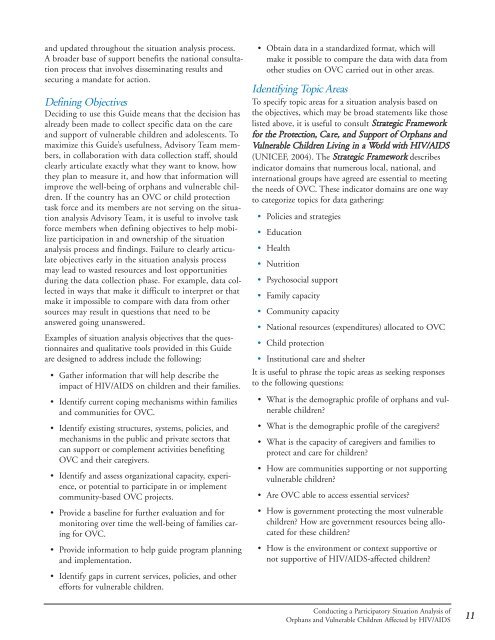Conducting a Participatory Situation Analysis of.pdf - Global HIV ...
Conducting a Participatory Situation Analysis of.pdf - Global HIV ...
Conducting a Participatory Situation Analysis of.pdf - Global HIV ...
You also want an ePaper? Increase the reach of your titles
YUMPU automatically turns print PDFs into web optimized ePapers that Google loves.
and updated throughout the situation analysis process.<br />
A broader base <strong>of</strong> support benefits the national consultation<br />
process that involves disseminating results and<br />
securing a mandate for action.<br />
Defining Objectives<br />
Deciding to use this Guide means that the decision has<br />
already been made to collect specific data on the care<br />
and support <strong>of</strong> vulnerable children and adolescents. To<br />
maximize this Guide’s usefulness, Advisory Team members,<br />
in collaboration with data collection staff, should<br />
clearly articulate exactly what they want to know, how<br />
they plan to measure it, and how that information will<br />
improve the well-being <strong>of</strong> orphans and vulnerable children.<br />
If the country has an OVC or child protection<br />
task force and its members are not serving on the situation<br />
analysis Advisory Team, it is useful to involve task<br />
force members when defining objectives to help mobilize<br />
participation in and ownership <strong>of</strong> the situation<br />
analysis process and findings. Failure to clearly articulate<br />
objectives early in the situation analysis process<br />
may lead to wasted resources and lost opportunities<br />
during the data collection phase. For example, data collected<br />
in ways that make it difficult to interpret or that<br />
make it impossible to compare with data from other<br />
sources may result in questions that need to be<br />
answered going unanswered.<br />
Examples <strong>of</strong> situation analysis objectives that the questionnaires<br />
and qualitative tools provided in this Guide<br />
are designed to address include the following:<br />
• Gather information that will help describe the<br />
impact <strong>of</strong> <strong>HIV</strong>/AIDS on children and their families.<br />
• Identify current coping mechanisms within families<br />
and communities for OVC.<br />
• Identify existing structures, systems, policies, and<br />
mechanisms in the public and private sectors that<br />
can support or complement activities benefiting<br />
OVC and their caregivers.<br />
• Identify and assess organizational capacity, experience,<br />
or potential to participate in or implement<br />
community-based OVC projects.<br />
• Provide a baseline for further evaluation and for<br />
monitoring over time the well-being <strong>of</strong> families caring<br />
for OVC.<br />
• Provide information to help guide program planning<br />
and implementation.<br />
• Obtain data in a standardized format, which will<br />
make it possible to compare the data with data from<br />
other studies on OVC carried out in other areas.<br />
Identifying Topic Areas<br />
To specify topic areas for a situation analysis based on<br />
the objectives, which may be broad statements like those<br />
listed above, it is useful to consult Strategic Framework<br />
for the Protection, Care, and Support <strong>of</strong> Orphans and<br />
Vulnerable Children Living in a World with <strong>HIV</strong>/AIDS<br />
(UNICEF, 2004). The Strategic Framework describes<br />
indicator domains that numerous local, national, and<br />
international groups have agreed are essential to meeting<br />
the needs <strong>of</strong> OVC. These indicator domains are one way<br />
to categorize topics for data gathering:<br />
• Policies and strategies<br />
• Education<br />
• Health<br />
• Nutrition<br />
• Psychosocial support<br />
• Family capacity<br />
• Community capacity<br />
• National resources (expenditures) allocated to OVC<br />
• Child protection<br />
• Institutional care and shelter<br />
It is useful to phrase the topic areas as seeking responses<br />
to the following questions:<br />
• What is the demographic pr<strong>of</strong>ile <strong>of</strong> orphans and vulnerable<br />
children?<br />
• What is the demographic pr<strong>of</strong>ile <strong>of</strong> the caregivers?<br />
• What is the capacity <strong>of</strong> caregivers and families to<br />
protect and care for children?<br />
• How are communities supporting or not supporting<br />
vulnerable children?<br />
• Are OVC able to access essential services?<br />
• How is government protecting the most vulnerable<br />
children? How are government resources being allocated<br />
for these children?<br />
• How is the environment or context supportive or<br />
not supportive <strong>of</strong> <strong>HIV</strong>/AIDS-affected children?<br />
• Identify gaps in current services, policies, and other<br />
efforts for vulnerable children.<br />
<strong>Conducting</strong> a <strong>Participatory</strong> <strong>Situation</strong> <strong>Analysis</strong> <strong>of</strong><br />
Orphans and Vulnerable Children Affected by <strong>HIV</strong>/AIDS<br />
11















